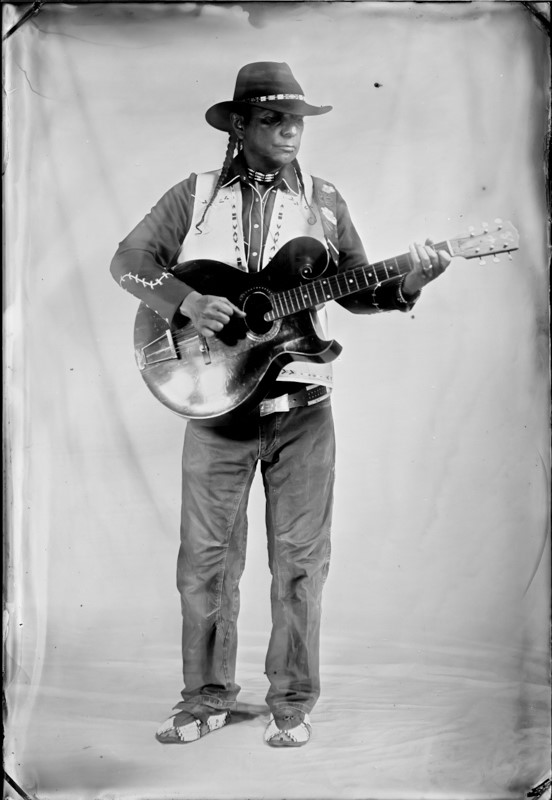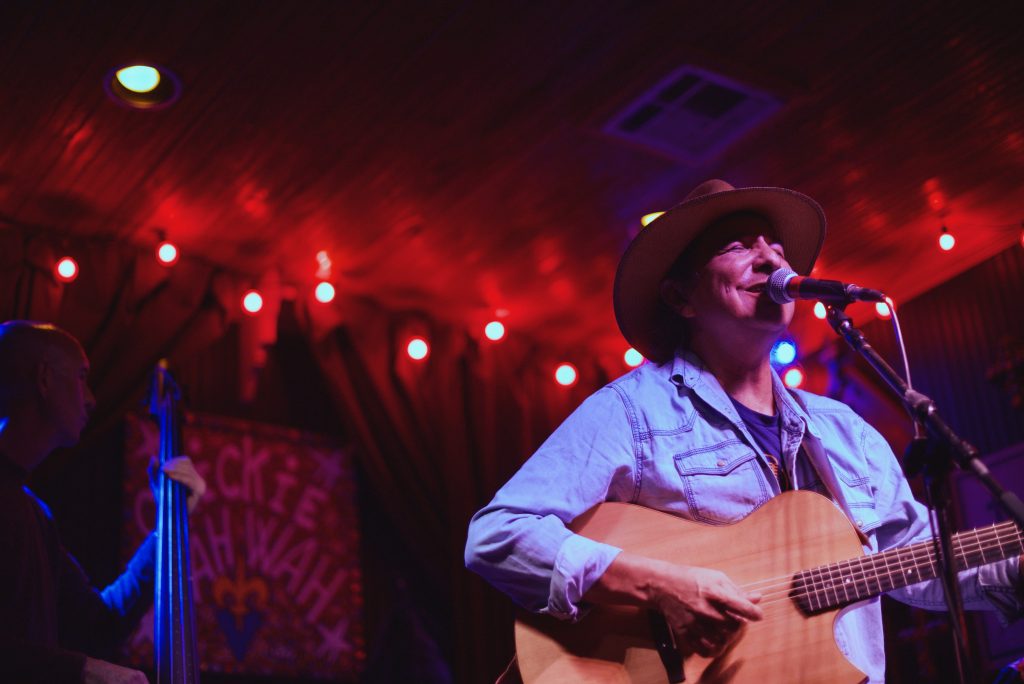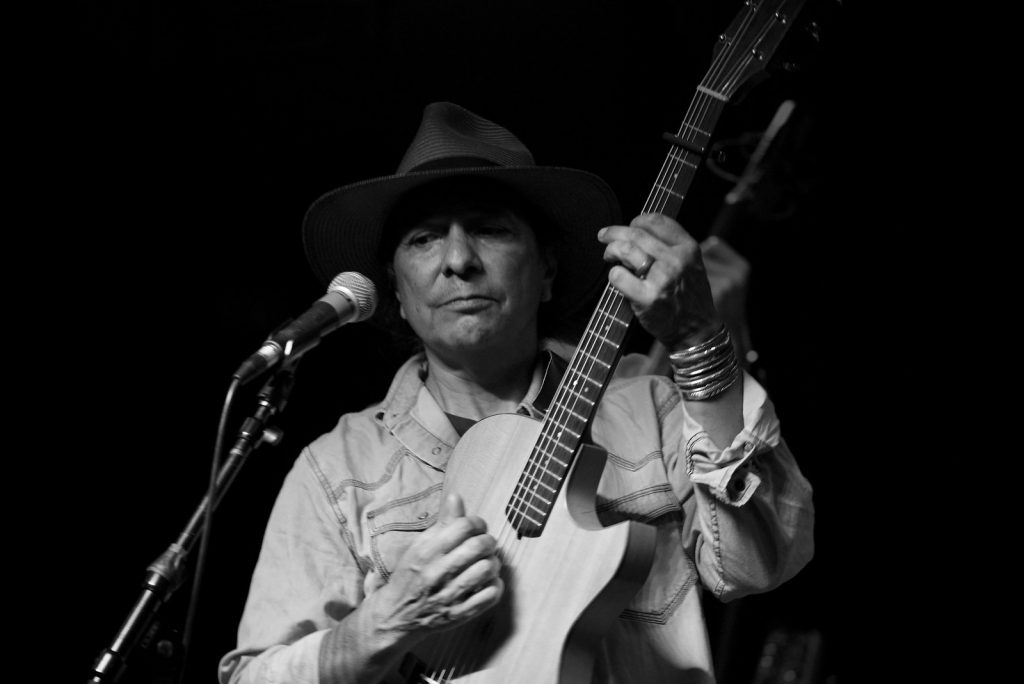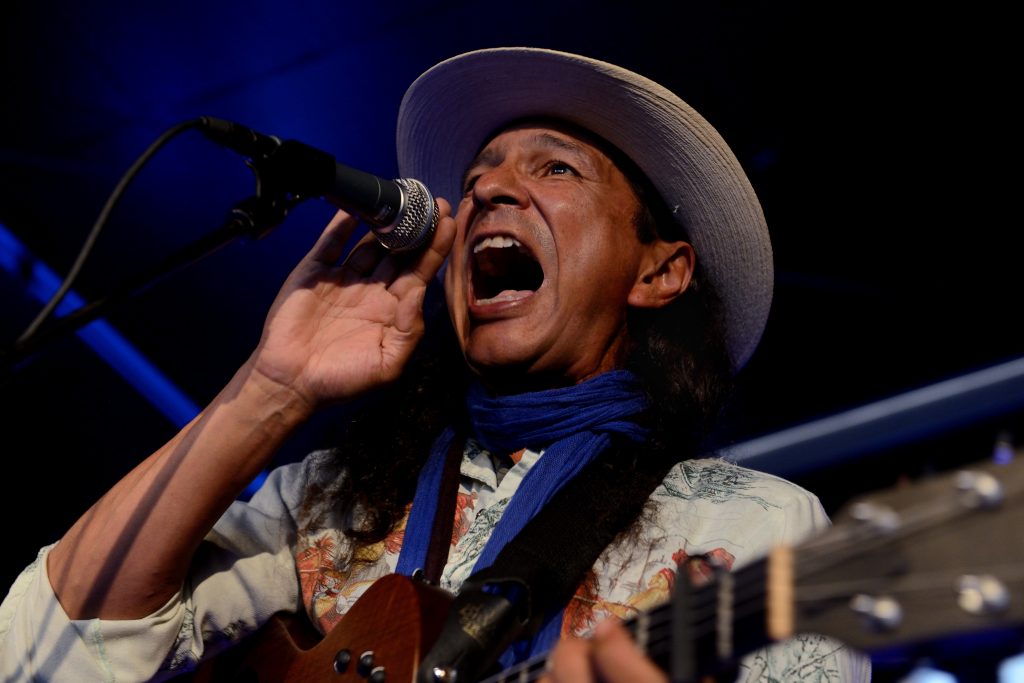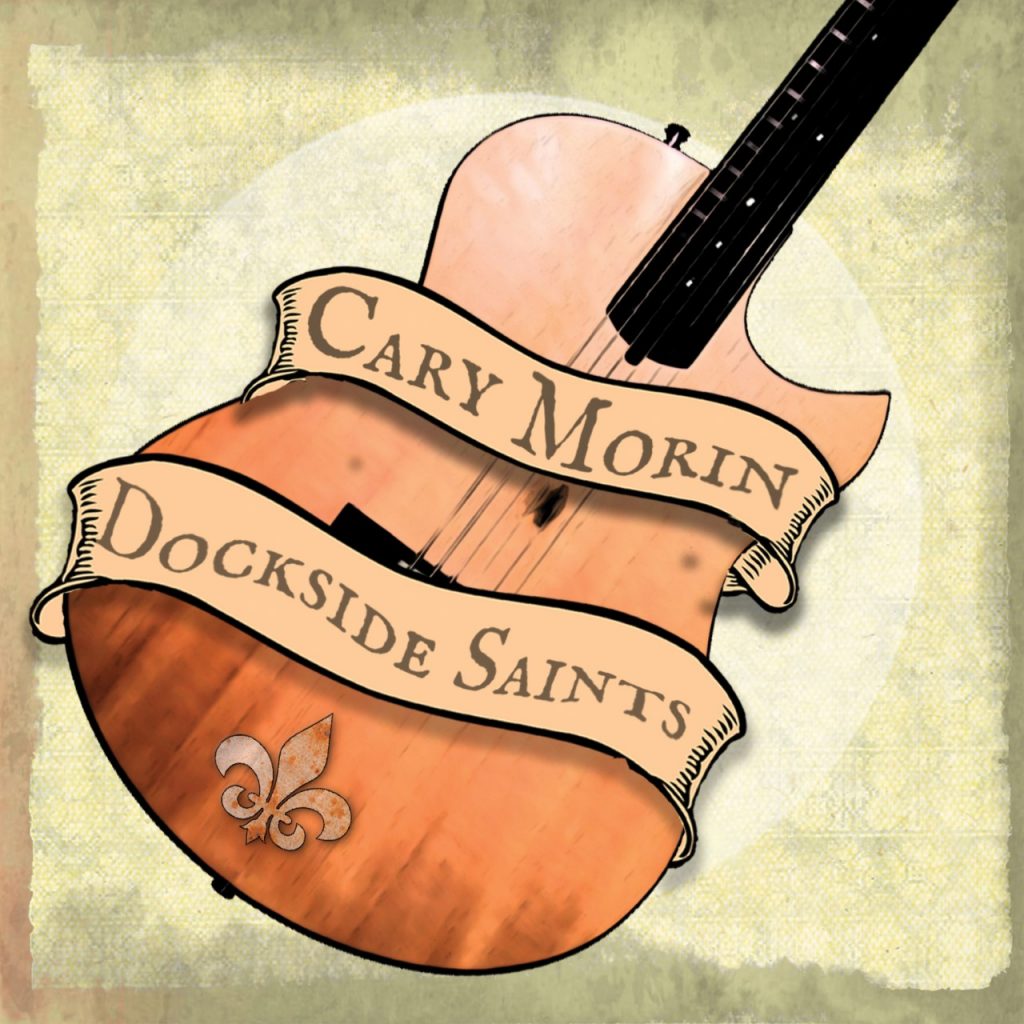From the new album, Dockside Saints, Cary Morin’s finger-style Native Americana tribute to his Crow heritage needs to be put on repeat.
There’s so much we didn’t know about phenomenal Americana blues musician and enrolled Crow tribal member Cary Morin. Like the fact that the Colorado-based guitar virtuoso tours America with a 10-pound Shih Tzu named Zeus.
If that doesn’t immediately endear Morin to you, his new record — Dockside Saints, due out August 7, 2020 — surely will. But you don’t even have to wait till then: We’re premiering one of the tracks right here.
The new album has a New Orleans flavor and features an all-star cast of topnotch players from the Lafayette, Louisiana, area. Recorded at the renowned Dockside Studio in Vermillion Parish, it was produced by the multi-Grammy-winning Tony Daigle.
The press materials describe Dockside Saints as “a spirited gumbo combining zydeco, Cajun, and Creole with generous portions of Piedmont blues and country, and dashes of gospel and folk.”
Add to the gumbo the homage that Morin pays to his Native American heritage — it’s the secret ingredient that makes his music so deliciously soul-satisfying.
We’re premiering the fourth track, “Valley of the Chiefs,” which touches on that Crow heritage: “We are the children of the long-beaked bird / traveling as captives into the night / taken far from the valley / no tears were cried / toward the eastern light.”
“It’s based on a true story told by my great-grandmother at my Crow naming ceremony when I was about 4 years old,” says Morin. “It tells of when she was a teenager and was kidnapped by a neighboring tribe. When women were kidnapped back then, they were destined to a life of servitude. She and her friends escape the warriors and are able to steal their horses and ride back home. The moral of the story from my great-grandmother to me was that there is nothing in life that you cannot overcome.”
Morin believes his great-grandmother was giving him this story to teach him perseverance in the face of any obstacles he might experience in life and he wrote “Valley of the Chiefs” as a “memory of my life and my culture.”
He’s written songs about the Crow side of his family for years. “Not many of those songs were ever published until recently in my career,” Morin says. “Earlier in my life, I probably thought that sharing these stories and family history was too personal.”
But these days he thinks it would be interesting to ask other Crow people about their own specific naming ceremony stories. “Now, I feel it is important to share this history and continue the oral history of my people. I’ve always wanted to hear this song with a different presentation. I had previously recorded it as a solo tune. I wanted a presentation with sweeping melodic lines.”
Morin constantly finds inspiration in his Indigenous heritage and seeks out Native culture wherever he finds himself.
“The ancient Native culture of the South has been an inspiration as it relates to our travels and what has become an annual pilgrimage to the Mississippi Valley,” he says. “As my wife, Celeste, and I traverse this country, my eyes are flooded with landscapes and visions that gift me with an endless supply of songs. This new collection represents our annual migration, just as my ancestors migrated from this region to the Western plains so many centuries ago, sharing culture through music and more along the way. It is the product of our imagination of what was, and what has become our love of the sounds of the South.”
We settled in for a long and enlightening conversation with one of the best guitar players we know.
Cowboys & Indians: How did this album come together?
Cary Morin: I tour with my wife, Celeste; she manages me and a few other artists and we also perform together. We used to do a duo act called Cowgirl & NDN. We were doing shows in Louisiana and a friend of ours, who is a well-known drummer from the Lafayette area, offered to introduce us to a legendary studio there. We had been talking about trying to create a band around my songs with regional players. He took us to Dockside Studio in Maurice, Louisiana. We were impressed with the property and the vibe of the studio. I started putting together a collection of songs and recorded them at home so we would have something for our potential band to listen to. I was pleased when everyone said yes to the project.
The next thing to do was book the time and go meet the players. We met Tony Daigle at one of my shows, where he commented that should we ever record a project in Lafayette, he would be happy to produce.
We played for a week, many very long days. We would start every song by listening to the preproduction I had prepared at home. Then I would sit back and listen to song after song as though it was being born and heard for the first time. It was a magical week where good friends were made, and I can only imagine what the future holds with these amazing artists. They are my heroes! They are the Dockside Saints!
C&I: Who wrote the songs and what were the circumstances and setting?
Morin: I wrote the songs. There were a few tunes I had used on previous projects and I was very interested to see what this band would do with them. Some of the songs were written on tour in the U.S., some on tour in Europe. Some of the songs written in Europe were inspired by being in old towns that seemed to remind me of being in New Orleans. Since I didn’t know any of the players or have any idea what the songs were going to sound like, I could only use my imagination and hope that the content fit the music. It worked — everything was spot-on!
The songs written in the U.S. were inspired by our wandering around the Mississippi Valley. I often try and see that part of the country the way that it must have been before the interstates and buildings existed. A time when the Native people were Mound Builders and traveled trading between cities all along the valley, from the Great Lakes all the way down to the Gulf of Mexico. I like to think that I am doing the same as those tribes from long ago, traveling and sharing art. It’s fascinating and inspirational history.
C&I: How do you label or describe your music?
Morin: This has always been a tough thing for me to do. In my 20s, I was playing in dance bands, so I tried to craft songs that worked on the dance floor. I was interested in reggae and world-beat music, but I don’t feel like I was ever good enough at it to call myself a reggae artist, though the music was inspiring to me. It still is. From my time with Pura Fe I became more interested in blues music and listened to many artists that were new to me. All of my years of guitar playing started to make sense. I could get a sense of where the musical roots lie in the music I have pursued for much of my life. Those roots are in New Orleans, where everything comes from!
All the years that I played in the Midwest, in Minneapolis where I spent much of my time, in towns along the Mississippi River, they all lead down the river to New Orleans. The Mississippi River and all the towns in that valley are where I spend much of my time now. The music that I create is the result of so many influences; I don’t know what to call it, other than Native Americana. My life has been spent learning about music and performance and I doubt that will ever end. When I stop learning is when I stop everything.
C&I: Who are some of your musical influences?
Morin: My musical influences were originally recording artists that I heard growing up. I used to say my favorite sources of inspiration were Bob Wills, Bob Dylan, and Bob Marley. I guess that is true today as well, but I feel that I have learned the most from being on stage with other artists. My biggest challenge in life was to become comfortable on stage and I’ve come closer to that goal from watching my friends and how they create a bond with an audience. Some are well-known childhood heroes and some are folks that I have only known for a short time. I’ve been lucky to pick something up from all of them and always continue to learn from them.
C&I: What were the first inklings that a Crow kid in Montana would tour the world with his music?
Morin: I was born in Billings, Montana, and I’m enrolled with the Crow Tribe in Montana. My father was in the military, so we moved around a bit, but not as much as some. He eventually got stationed in Great Falls, Montana. That is where I spent the bulk of my youth. My dad bought a house about half a mile from the Missouri River, about 10 miles from town. That is the house I remember as my childhood home. I worked a little in Jackson, Wyoming, after high school but soon ended up in Fort Collins, Colorado, around 1982. I’ve lived here ever since.
I took piano lessons starting in 1st grade through high school. I loved to listen to songs and figure out how to play them. The first song I ever played and sang was from New Orleans, Fats Domino’s “Blueberry Hill.” I was about 10 years old. I was interested in piano rags and rock ’n’ roll. When I was about 12 years old I started playing some of the guitars that were always around the house. My dad played and one of my older brothers played too. I found it easy to figure out chords and play things I heard from records. I was a terrible piano student, but I sure could play by ear. It’s sort of a blessing and a curse. I find it easy to play with other musicians but hard to communicate with them since I never did read music very well.
C&I: Besides the three Bobs, who did you grow up listening to?
Morin: My folks listened to country music mostly. I could play along with my dad when he did Willie Nelson tunes. They liked old country tunes — Jimmy Rodgers, Hank Snow, Merle Haggard, Charley Pride, Hank Williams. From my older brother and the older brothers of some of my friends, I enjoyed James Taylor, Cat Stevens, Jimmy Buffet, Bruce Cockburn, Joni Mitchell, Neil Young, and so on. I eventually became interested in guitar players — Leo Kottke, Mark Knofler, George Benson, Jeff Beck, David Bromberg, Lindsay Buckingham, and a bunch of bluegrass players. My focus was pretty much out of focus. I was into Led Zeppelin, country, bluegrass, and classical music. I got interested in playing fiddle somewhere in there too. I loved Doug Kershaw.
I didn’t really know much about musical genres. I just loved music because of the song or the players. I listened to so much country music as a child that it stuck in my head. When I was an adult working on recordings, I decided I wanted some pedal steel in some songs so I bought one. I could still hear the steel in my head from when I was a child and knew how it was supposed to sound. I don’t really play steel that much, but I do sit in with bands from time to time and still use it on recordings often.
C&I: What was your big break and what are some career high points thus far?
Morin: My big break was my parents. They supported everything I did or wanted to do. They never discouraged me from playing music. After I left home and started playing solo shows around Colorado, they would drive from Montana to see shows. They were always there for me. My mom still comes to shows when she can. She has lived in Fort Collins for almost 30 years. Most people that know me know my mom too. When my children were young, she encouraged me to share our culture with them, teach them about traditional dance, and take them to powwows around the West. I did that for years and she still makes them dance regalia and loves to watch them dance. Powwow was a huge part of their growing up. I will be forever thankful for that.
After playing with a dance band here in Colorado for about 20 years I got a call from an old friend, Pura Fe. Her group, Ulali, was on hold for a while and she asked me if I was interested in playing guitar with her trio. I didn’t really know much about blues music, but I jumped at the chance. I played with her for years and learned about touring from the dozens of tours in Europe that we did. It was my honor to sit next to her and watch how she interacted with audiences in larger concert halls. The education I got from that experience paved the way for my own tours and gave me the confidence to play in front of bigger crowds as a solo artist. That was a new thing for me and it took me some time to figure it out. I’m still trying to figure it out! Moving from playing guitar with bands to doing solo shows was a big step for me. It has made it easier for me to step back into the band role again. I’ve always tried to change with the music industry as it constantly changes.
C&I: What’s your process like?
Morin: My songwriting has been an ongoing process. It’s sort of like building a sandcastle. Build one that’s okay, but the next one will be built upon the lessons of the previous one, and so on. You can almost always build one as good as the last one, but the trick is to craft the next one even better. I’ve developed stories over the years so that I could write songs about the characters. I have fictional characters that I’ve gotten to know pretty well over the years and continue to write songs about them. I don’t often come up with a concept and attempt to write a song about it. I hold the brush and let the painting create itself most of the time. Since I don’t try to force anything to happen, songs grow on their own and I let the listener decide what it means to them. Sometimes the songs mean something different to me than they do to others, and I like that about them. Just the fact that the songs mean anything to anybody makes me feel like I’m doing something important.
C&I: What’s something people might be surprised to learn about you?
Morin: I struggled with stage fright for many years. Even after being in front of crowds of thousands, I could never really get comfortable with it. I’m not sure what that was. Sometimes I would even think I was in danger of passing out! The cure turned out to be pretty simple. I play so much guitar at home now; I rehearse as much as my other responsibilities will allow. I know my material so well that nothing can rattle me. I’ve been doing solo shows for the last several years, and that has helped.
C&I: Back to the new record: Congrats again on the release of Dockside Saints, which “Valley of the Chiefs” comes off of. The album comes out on August 7. Besides being soulful, it’s super-accomplished. Tell us about the album personnel.
Morin: Tony Daigle (producer), Lee Allen Zeno (bass), Brian Brignac (drums), Corey Ledet (accordion), John Fohl (guitar), Beau Thomas (fiddle), Eric Adcock (piano / keyboards),
Keith Blair (guitar), Celeste Di Iorio (vocals).
C&I: What have you been doing during lockdown?
Morin: We were in the middle of a tour when the U.S. shut down. The drive home was the strangest in memory. Driving across the US and not seeing much traffic the whole way was eerie. Since then, I’ve learned a whole lot about live streaming. I thought I was going to be playing guitar more than usual, but the absence of work has created new chores that seem to take up much of my time. I have done very little home recording, which is always what turns into a new CD. I plan on changing that in the coming weeks, when I hope to get back to my roots and start creating new solo performances. I’ll continue on the songwriting path I was on before the lockdown and leave the pandemic songs for somebody else. I’ll continue to write, and dream, and try to make a moment in time for listeners to get away from reality, if only for a moment.
For more on Cary Morin, visit his website, or follow him on Facebook, Twitter, or YouTube.
Dockside Saints Track List
Nobody Gotta Know (4:11)
Exception to the Rule (3:54)
Prisoner (6:12)
Because He Told Me So (4:17)
Tonight (4:10)
Jamie Rae (4:30)
Bare Trees (4:22)
Valley of the Chiefs (3:39)
Chosen Road (4:26)
Cary’s Groove (4:58)
Blue Delta Home (4:11)
Come the Rain (4:20)
Cary Morin’s Good Mood Playlist
“Sabine Turnaround” – Lost Bayou Ramblers
“Amelia” — Joni Mitchell
“Yellow Moon” — Neville Brothers
“Plumb Line” — Kelly Joe Phelps
“Such a Night” — Dr. John
“Does My Ring Hurt Your Finger” — Charley Pride
“Mahk Jchi” — Pura Fe
“Ain’t No Way” — David Lindley
“Love and Happiness” — Al Green
“Down in Hollywood” — Ry Cooder
“One Drop” — Bob Marley
“Jokerman” — Bob Dylan
“Roly Poly” — Bob Wills







